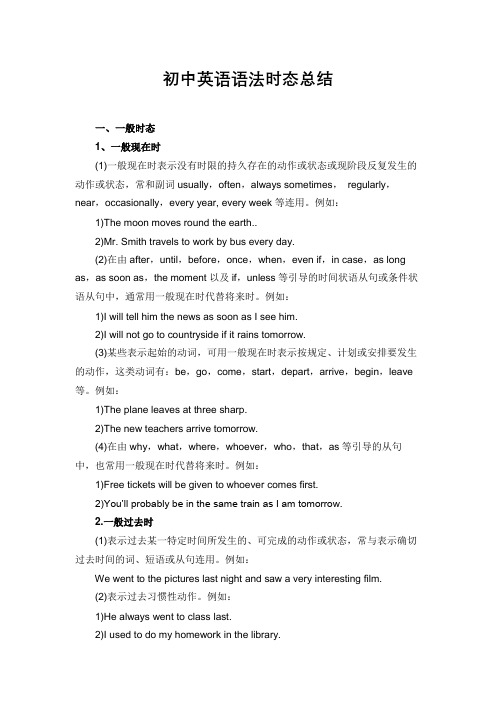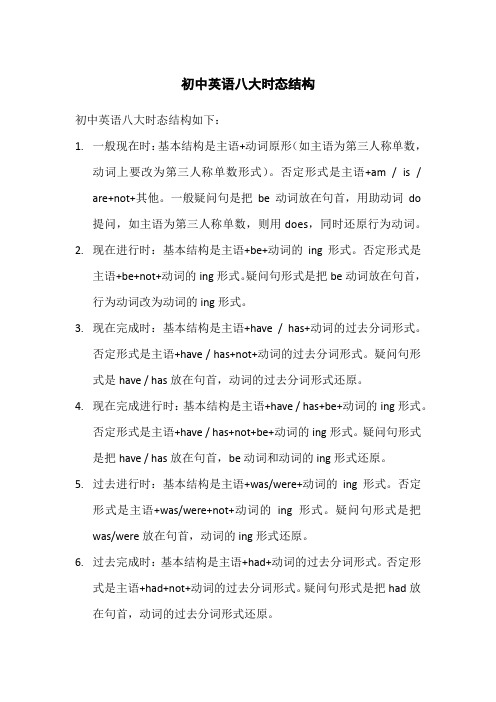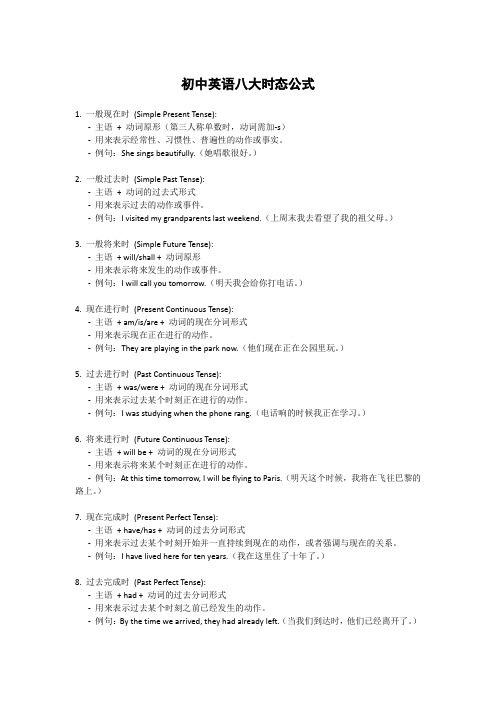初中英语一般现在时
- 格式:pdf
- 大小:274.71 KB
- 文档页数:11

初中英语语法时态总结一、一般时态1、一般现在时(1)一般现在时表示没有时限的持久存在的动作或状态或现阶段反复发生的动作或状态,常和副词usually,often,always sometimes,regularly,near,occasionally,every year, every week等连用。
例如:1)The moon moves round the earth..2)Mr. Smith travels to work by bus every day.(2)在由after,until,before,once,when,even if,in case,as long as,as soon as,the moment以及if,unless等引导的时间状语从句或条件状语从句中,通常用一般现在时代替将来时。
例如:1)I will tell him the news as soon as I see him.2)I will not go to countryside if it rains tomorrow.(3)某些表示起始的动词,可用一般现在时表示按规定、计划或安排要发生的动作,这类动词有:be,go,come,start,depart,arrive,begin,leave 等。
例如:1)The plane leaves at three sharp.2)The new teachers arrive tomorrow.(4)在由why,what,where,whoever,who,that,as等引导的从句中,也常用一般现在时代替将来时。
例如:1)Free tickets will be given to whoever comes first.2)You’ll probably be in the same train as I am tomorrow.2.一般过去时(1)表示过去某一特定时间所发生的、可完成的动作或状态,常与表示确切过去时间的词、短语或从句连用。


初中英语八大时态结构初中英语八大时态结构如下:1.一般现在时:基本结构是主语+动词原形(如主语为第三人称单数,动词上要改为第三人称单数形式)。
否定形式是主语+am / is / are+not+其他。
一般疑问句是把be动词放在句首,用助动词do 提问,如主语为第三人称单数,则用does,同时还原行为动词。
2.现在进行时:基本结构是主语+be+动词的ing形式。
否定形式是主语+be+not+动词的ing形式。
疑问句形式是把be动词放在句首,行为动词改为动词的ing形式。
3.现在完成时:基本结构是主语+have / has+动词的过去分词形式。
否定形式是主语+have / has+not+动词的过去分词形式。
疑问句形式是have / has放在句首,动词的过去分词形式还原。
4.现在完成进行时:基本结构是主语+have / has+be+动词的ing形式。
否定形式是主语+have / has+not+be+动词的ing形式。
疑问句形式是把have / has放在句首,be动词和动词的ing形式还原。
5.过去进行时:基本结构是主语+was/were+动词的ing形式。
否定形式是主语+was/were+not+动词的ing形式。
疑问句形式是把was/were放在句首,动词的ing形式还原。
6.过去完成时:基本结构是主语+had+动词的过去分词形式。
否定形式是主语+had+not+动词的过去分词形式。
疑问句形式是把had放在句首,动词的过去分词形式还原。
7.过去完成进行时:基本结构是主语+had+be+动词的ing形式。
否定形式是主语+had+not+be+动词的ing形式。
疑问句形式是把had 放在句首,be动词和动词的ing形式还原。
8.一般将来时:基本结构是主语+will/shall/be going to+动词原形。
否定形式是主语+will/shall/be going to+not+动词原形。
疑问句形式是把will/shall/be going to放在句首,动词原形还原。

初中英语八大时态公式1. 一般现在时(Simple Present Tense):-主语+ 动词原形(第三人称单数时,动词需加-s)-用来表示经常性、习惯性、普遍性的动作或事实。
-例句:She sings beautifully.(她唱歌很好。
)2. 一般过去时(Simple Past Tense):-主语+ 动词的过去式形式-用来表示过去的动作或事件。
-例句:I visited my grandparents last weekend.(上周末我去看望了我的祖父母。
)3. 一般将来时(Simple Future Tense):-主语+ will/shall + 动词原形-用来表示将来发生的动作或事件。
-例句:I will call you tomorrow.(明天我会给你打电话。
)4. 现在进行时(Present Continuous Tense):-主语+ am/is/are + 动词的现在分词形式-用来表示现在正在进行的动作。
-例句:They are playing in the park now.(他们现在正在公园里玩。
)5. 过去进行时(Past Continuous Tense):-主语+ was/were + 动词的现在分词形式-用来表示过去某个时刻正在进行的动作。
-例句:I was studying when the phone rang.(电话响的时候我正在学习。
)6. 将来进行时(Future Continuous Tense):-主语+ will be + 动词的现在分词形式-用来表示将来某个时刻正在进行的动作。
-例句:At this time tomorrow, I will be flying to Paris.(明天这个时候,我将在飞往巴黎的路上。
)7. 现在完成时(Present Perfect Tense):-主语+ have/has + 动词的过去分词形式-用来表示过去某个时刻开始并一直持续到现在的动作,或者强调与现在的关系。

初中英语一般现在时用法和意义一般现在时(Simple Present Tense)是英语中最基本也是最常用的一种时态,表示经常性或习惯性的动作、客观真理、常规现象等。
以下是一般现在时的用法和意义的详细解释:1.表示经常性的动作或习惯:- I often play basketball with my friends after school.- She always brushes her teeth before going to bed.- They usually have dinner together as a family.2.表示现阶段的状态或情况:- The weather looks nice today.- He is a student at a local high school.- My sister is busy preparing for her exams at the moment.3.表示普遍真理、客观事实或一般规律:- Water boils at 100 degrees Celsius.- The sun rises in the east and sets in the west.- Cats have fur and dogs have hair.4.表示日程表中的安排或固定的时间表:- The train to London departs every 30 minutes.- The bus arrives at 9 o'clock every morning.- The English class takes place on Monday and Wednesday.5.表示评论、意见或个人观点:- I think he is a talented musician.- The movie is very interesting.- They believe in working hard to achieve success.6.表示感觉或外貌形态:- The cake smells delicious.- The flowers look beautiful in the garden.- The music sounds pleasant.7.口头表达指令、建议或禁令(一般情况下):- Close the door, please.- Don't run in the hallway.- Be quiet during the movie.8. 结构“there be”表示处存在物或人:- There is a park near my house.- There are many books on the shelf.- There is a girl waiting for you at the entrance.需要注意的是,一般现在时通常用于第三人称单数时,动词的变化需要在动词原形的基础上加上“s”或“es”后缀:- I play ▶︎ He plays- They go ▶︎ She goes- We have ▶︎ It has总结起来,一般现在时是英语中最基础的一种时态,用于表示经常性或习惯性的动作、客观真理、常规现象等。

初中英语知识点归纳一般现在时的构成与用法一、一般现在时的构成一般现在时表示经常性、习惯性或客观事实等,构成方式如下:1. 肯定句:主语 + 动词原形/动词的第三人称单数形式例:I like reading books.(我喜欢读书。
)He eats an apple every day.(他每天吃一个苹果。
)2. 否定句:主语 + do not/does not + 动词原形例:They do not watch TV at night.(他们晚上不看电视。
)She does not play basketball on weekends.(她周末不打篮球。
)3. 疑问句:Do/Does + 主语 + 动词原形?例:Do you speak English?(你会说英语吗?)Does she go to school by bus?(她乘公交车去学校吗?)4. 特殊疑问句:特殊疑问词 + do/does + 主语 + 动词原形?例:What do you do in your free time?(你空闲时做什么?)When does the movie start?(电影什么时候开始?)二、一般现在时的用法一般现在时用于以下几种情况:1. 表示经常性或习惯性的动作或状态。
例:My mother often cooks dinner for us.(我妈妈经常给我们做晚饭。
)We usually go to the park on weekends.(我们通常在周末去公园。
)2. 表示客观事实、自然规律或科学真理。
例:The sun rises in the east.(太阳从东方升起。
)Water boils at 100 degrees Celsius.(水在100摄氏度沸腾。
)3. 表示现有状况或个人特征。
例:I have two cats.(我有两只猫。
)She lives in London.(她住在伦敦。
初中英语一般现在时知识点一般现在时是指在现在发生或存在的动作、状态和习惯。
以下是一般现在时的知识点:1. 形式:一般现在时的形式为主语 + 动词原形(或第三人称单数形式)、主语 + be动词原形(am, is, are)+ 动词-ing形式。
2. 第三人称单数形式:当主语是第三人称单数(he, she, it)时,动词要加 -s或 -es。
例如:She likes to play the piano.3. be动词的使用:be动词表示临时状态、习惯性状态和现有派生动词的被动语态。
例如:I am a student. They are playing soccer. The book is being read.4. 动词的形式变化:有些动词在一般现在时态中有特殊的形式变化。
例如:go -> goes, do -> does, have -> has。
5. 可数名词和不可数名词:可数名词使用单数形式,不可数名词使用单数或不变形式。
例如:She has two cats. I have a lot of water.7. 表示真理、自然现象和客观事实:一般现在时也可以用来表示真理、自然现象和客观事实。
例如:The sun rises in the east. Water boils at 100 degrees Celsius.8. 表示未来时间:一般现在时有时也可以用来表示未来安排或时间表中的事件。
例如:The train leaves at 6 o'clock tomorrow.9. 否定句和疑问句:一般现在时的否定句结构为主语 + donot/does not + 动词原形。
疑问句结构为Do/Does + 主语 + 动词原形。
以上是一般现在时的主要知识点,通过学习和掌握这些知识点,你就能正确运用一般现在时来描述现在的动作、状态和习惯。
初中英语语法知识之一般现在时一、一般现在时的定义一般现在时是英语中最基本的时态之一,用于描述经常发生的事情、普遍的真理、长期存在的状态等。
二、一般现在时的构成一般现在时的肯定句结构为:主语 + 动词原形(第三人称单数需加-s/-es)+ 其他。
例如:•He plays basketball every day.(他每天打篮球。
)•I like watching movies.(我喜欢看电影。
)一般现在时的否定句结构为:主语 + do/does not + 动词原形 + 其他。
例如:•He does not play basketball every day.(他不是每天打篮球。
)•I do not like watching movies.(我不喜欢看电影。
)一般现在时的疑问句结构为:Do/Does + 主语 + 动词原形 + 其他?例如:•Does he play basketball every day?(他每天打篮球吗?)•Do you like watching movies?(你喜欢看电影吗?)三、一般现在时的用法1. 描述日常习惯一般现在时经常用来描述日常习惯或经常发生的动作。
表示频率的副词有:always(总是)、often(经常)、usually(通常)、sometimes(有时候)、rarely(很少)、never(从不)等。
例如:•She always eats breakfast before going to school.(她上学前总是吃早餐。
)•They often go shopping on weekends.(他们经常在周末去购物。
)2. 表达客观事实或普遍真理一般现在时也被用来表达客观事实或普遍真理。
例如:•The Earth revolves around the sun.(地球绕太阳运行。
)•Water boils at 100 degrees Celsius.(水在100摄氏度沸腾。
初中英语语法八大时态一.一般现在时1.结构肯定句式:主语+动词原形/动词的第三人称单数+其他否定句式:主语+(助动词)don't/doesn't+动词原形+其他一般疑问句式:Do/Does+主语+动词原形+其他简略回答:(肯)Yes,主语+do/does(否)No,主语+do/does not缩写形式:don't=do not doesn't=does not例句:He often goes swimming in summer.I usually leave home for school at7every morning.2.用法1)表示经常的、习惯性的动作或存在的状态,常与表示频度的副词连用。
常用的频度副词有:always、often、usually、seldom、never、sometimes,every week(day,year, month…),once a week,on Sundays.频度副词在句中通常放在行为动词之前,系动词、助动词之后。
例如:He often goes swimming in summer.I usually leave home for school at7every morning.2)表示主语具备的性格、特征和能力等。
例如:All my family love football.My sister is always ready to help others.Ann writes good English but does not speak well.3)表示客观真理、客观存在、自然现象。
例如:The earth moves around the sun.Shanghai lies in the east of China.4)表示按计划或安排好的,或将要发生的动作,可用一般现在时表将来。
但只限于start,begin,leave,go,come,arrive,return,take place等。
一般现在时讲解和练习
一、定义:一般现在时表示经常或习惯性的动作,也可表示现在的状态或主语具备的性格
和能力。
例:( 1) .表示事物或人物的特征、状态。
The sky is blue. 天空是蓝色的。
(2) .表示经常性或习惯性的动作。
I get up at six every day. 我每天六点起床。
(3) .表示客观现实。
The earth goes around the sun.地球绕着太阳转。
二、一般现在时常用时间状语、时间副词
in the morning/afternoon/evening
every week (day, year, month?)
on Sundays (Monday, Tuesday?)
at night, once a week,.
always 总是 , usually 通常 , often 经常 , sometimes 有时 , never 从不
三、用法:
1.肯定句:
(1)句中有 be(am,is, are)和情态动词时,
①be 动词时,主语是 I 时要用 am,主语是 you 时要用 are,其他用 is。
②是情态动词时,后面的动词用原型
③例: I am a student.
You are very beautiful.
She is my best friend.
He can do his homework by himself.
(2)没有be(am,is, are)动词和情态动词:
主语为第三人称单数( she ,he ,it )、单数可数名词、不可数名词的,动词要按规则
加上 s 或 es;主语是复数可数名词的肯定句,动词用原形。
例:① She( He, It ) likes fish.她(他,它)喜欢鱼。
(主语为第三人称单数)
② The table has four legs.桌子有四条腿。
(主语为单数可数名词 )
③ Water boils at 100 degrees Celsius.水在 100 度沸腾。
(主语为不可数名词)
They go to school every day . 他们每天都去上学。
(主语是复数可数名词的,动词用
原形)
注意的问题:第三人称单数以及第三人称单数时动词的变化规则
在一般现在时中,当主语是第三人称单数时,谓语动词要用第三人称单数形式,即常在动词原形后加 -s 或 -es。
但有些同学们对于哪些主语是第三人称单数还不十分清楚,
现归纳总结如下:
1、人称代词he, she, it 是第三人称单数。
如:
He likes watching TV.他喜欢看电视。
She has lunch at twelve. 她十二点吃午餐。
It looks like a cat.它看起来像只猫。
2、单个人名、地名或称呼作主语;是第三人称单数。
如:
①Han Mei looks like her mother. 韩梅看起来像她的母亲。
② Beijing is in China. 北京在中国。
③ Uncle Wang often makes cakes. 王叔叔经常做蛋糕。
3、单数可数名词或"this / that / the+ 单数可数名词"作主语时,是第三人称单数。
如:
①A horse is a useful animal. 马是有用的动物。
② This book is yours. 这本书是你的。
③That car is red. 那辆小汽车是红色的。
④ The cat is Lucy's. 这只猫是露茜的。
4、不定代词 someone, somebody, nobody, everything, something 等及指示代词 this, that 作主语时,是第三人称单数。
如:
①Everyone is here. 大家到齐了。
②There is something wrong with the watch. 这块手表有毛病。
③ This is a pen. 这是一支钢笔。
④ That is an eraser. 那是一块橡皮擦。
5、不可数名词作主语时为第三人称单数。
如:
①The milk is in the glass. 牛奶在玻璃杯里。
② The bread is very small. 那面包很小。
6、当数字或字母作主语时,看作第三人称单数。
如:
①"6" is a lucky number. "6" 是个吉利数字。
② "I" is a letter. "I" 是个字母。
动词 +s 的变化规则
1.一般情况下,直接加-s,如: cook-cooks, make-makes
runs gets likes collets takes plays climbs 2.以 s. x. sh. ch.o 结尾,加 -es,如:guess-guesses, wash-washes, watch-watches, go-goes 3.以―辅音字母 +y ‖结尾,变y 为 i, 再加 -es,如: study-studies
方法与发音:
1.一般情况下,直接加-s
eg. works, plays, rains, sees
2.以 sh, ch, s, x 或 o 结尾的词后加
–es
eg. washes, teaches, fixes, does, goes
3.以辅音字母加 -y 结尾的,先把 ?y‘改成 ?i ‘再,加 -es
eg. studies, flies, carries
注意 : 动词加-s 以后的读音 .
动词加 -s 后的读音1.在 [p] [t] [k] [f]等清辅音后,发清辅音/s/
eg. helps, works, likes, hates ,laughs
2.在浊辅音和元音后,发浊辅音/z/
eg. drives, cleans, plays
3.在 [s] [z] [t?]∫[d]?][后,发/iz/
rises, wishes, teaches, urges
4.在 [t] [d] 后,发/ts//dz/
eg. fits, sets, needs
5.其他情况下发 [z]
eg. plans, cries, shows。